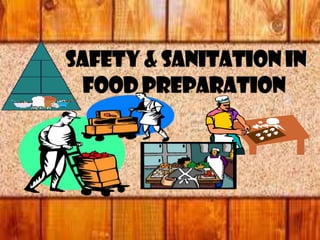
Week 5-Kitchen Safety and Sanitation.pptx
- 2. ALPHA CODE Using the alphabet, try to find out the hidden word.
- 3. 4 9 7 DIG
- 4. 4 1 14 7 5 18 DANGER
- 5. 8 1 26 1 18 4 HAZARD
- 6. 19 12 9 16 SLIP
- 7. 2 21 18 14 BURN
- 8. 3 21 20 CUT
- 9. 12 9 6 5 LIFE
- 10. 4 5 1 20 8 DEATH
- 11. SAFETY in the kitchen means using precautionary methods in the kitchen to prevent an accident. Most accidents in the kitchen are due to carelessness.
- 13. Basic Rules of Kitchen Safety
- 14. 1.Wear appropriate ,clean clothing on the lab days
- 15. 2. Never cook in loose clothes and keep long hair tied back. You don’t want anything accidentally catching fire.
- 16. 3. Store knives in a wooden block or in a drawer.
- 17. 4. Keep potholders nearby and use them!
- 18. 5. Don’t let temperature-sensitive foods sit out in the kitchen.
- 19. 6. Separate raw meat and poultry from other items whenever you use or store them.
- 20. 7. When possible use a kitchen tool, not your hands to complete tasks.
- 21. 8. Wipe up spills immediately. Keep the floor dry so that no one slips and falls.
- 22. 9. Get a fire extinguisher and First Aid Kit for your kitchen
- 24. OVERTHINK! What would be the worst case scenario if the workers do not apply safety knowledge in the work place? 1. Loose Clothes 2. Oily floor 3. Hair not tied 4. Knives are everywhere 5. No fire extinguisher is available
- 25. SEATWORK Write down the safety practices and the accidents that can be avoided through this. Example: Safety Practices Accidents Avoided Keeping the gas range close Fire/Death
- 27. ALPHA CODE Using the alphabet, try to find out the hidden word.
- 28. 4 9 7 DIG
- 29. 7 5 18 13 19 germs
- 30. 2 1 3 20 5 18 9 1 BACTERIA
- 31. 23 1 19 8 9 14 7 WASHING
- 32. 3 12 5 1 14 9 15 7 CLEANING
- 33. 9 12 12 14 5 19 19 ILLNESS
- 35. SANITATION is the process of handling food in ways that are clean and healthy.
- 36. 1. Wash your hands before handling food and after handling meat or poultry.
- 37. 2. Repeatedly wash your hands when necessary – especially after coughing, sneezing or using the restroom.
- 38. 3. Wash dishes, pans and utensils as you use them, allowing them to dry on the drain board when possible.
- 39. 4. When tasting foods, use a spoon other than the one used for stirring . Use a clean spoon for each person tasting and for each time food tasted.
- 40. 5. Proper garbage disposal
- 43. ⚫ 1) Cross- contamination between raw and cooked and/or ready-to-eat foods. It generally results from poor personal hygiene (worker’s hands), or from using unsanitized equipment
- 44. 2) Inadequate re-heating of potentially hazardous foods. All leftovers intended must be re-heated to 165 oF within a 2-hour period
- 45. ⚫3) Foods left in the temperature danger zone (TDZ) too long. Time in the TDZ is cumulative. After 4 hours the potentially hazardous foods must be discarded
- 47. ⚫5) Foods prepared too far in advance. This is generally coupled with holding food in the TDZ too long
- 48. 6)Infected food handlers and poor work habits.
- 49. ⚫7) Failure to properly heat or cook food
- 50. 8) Failure to properly cool food, poor cooling practices result in potentially hazardous foods being held in the TDZ for long periods of time
- 51. Time to learn how to FIGHT BAC !
- 52. CLEAN: Wash hands and surfaces often. SEPARATE: Don’t cross contaminate COOK: To proper temperatures CHILL: Refrigerate promptly.
- 54. Sanitation is more important than independence -Mahatma Ghandi
- 56. PREPARING MEAL SAFEANDSANITARY ENSURE PHYSICAL, MENTALANDEMOTIONAL SECURITYANDCHANCE TOBECOM E PRODUCTIVE INDIVIDUAPO//’//’L.
- 68. Directions: Write S if the statement is SAFE , write US if the statement is UNSAFE . 1. Use a towel or your apron to remove a pan from the oven. 2. Store knives in a wooden block or in a drawer. 3. Wipe up spills on the floor right away. 4. Patronizing street foods. 5. Tie back long hair. 6. All bullying incidents shall be reported to the School CPC. 7. Use electric appliances with wet hands. 8. Wearing loose clothing while working in the kitchen. 9. Cut away from your body when using a sharp knife. 10. Keep cabinet doors open so everything is in easy reach. SAFE SAFE SAFE SAFE UNSAFE UNSAFE SAFE UNSAFE UNSAFE UNSAFE